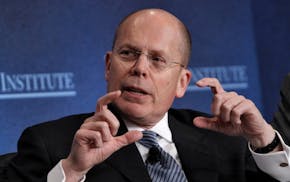Sarah Beth Ryther would love to have a car, her own apartment and eventually a child. But she thinks that seems unreachable as, like most of her co-workers at Trader Joe's in Minneapolis, she earns $16 to $20 an hour.
A family "is something I definitely can't afford. I don't make enough to pay for health care," she said, let alone a better apartment — at her present home, ice sheets form in the bath tub because of heating problems.
Ryther is one of many Americans on the flip side of the Federal Reserve's siege against inflation.
The central bank is watching to confirm their series of interest rate hikes — 11 since March 2022 — are working to rein in the U.S. economy and drop the inflation rate to 2% from 3.4%. The Fed, ahead of its next inflation update Feb. 13, is celebrating signs that wage growth, which reached its highest levels in decades in 2022, is now slowing. And that's good news for the Fed that inflation might be under control.
But for workers like Ryther, who are still struggling to afford the basics, there's anxiety that recent wage gains — which came after decades of stagnant wage growth — could vanish as quickly as they appeared.
Adjusted for inflation, weekly wages for the median worker grew 1.7% between 2019 and 2023, according to the U.S. Treasury Department. Though earnings have outpaced price increases compared to 2019, it hasn't been enough to give most people a "bread and roses" lifestyle, Ryther said.
"Wage growth remains high but has been gradually moving toward levels that would be more consistent with 2% price inflation over time," Fed Chair Jerome Powell said in a Dec. 1 speech in Atlanta.
The idea is the cost of wages gets passed on to consumers through higher prices, which then reduce buying power. And while that makes sense in theory, it's a little harder to swallow for those trying to make a living off a rate close to minimum wage.
"For me, it's really simple: The economy is good when people are able to afford to live," said Sheigh Freeberg, secretary/treasurer of Unite Here Local 17, which represents Minnesota hospitality workers. "And it's really frustrating for myself and for working people that a lot of economists think that the economy is good when wage growth slows down, because that means people's lives are harder."
'Nobody's getting rich over this'
Wages and benefits haven't kept pace with productivity for nearly half a century, as corporate income has bolstered executive compensation and shareholder profits over worker pay.
Following the height of the COVID-19 pandemic, worker pay spiked as unemployment fell: In June 2022, civilian workers' wages and salaries clocked year-over-year growth of more than 5% after hovering around 3% for years, according to the U.S. Department of Labor. That number has begun to drop: Compensation costs for civilian workers increased 4.2% year-over-year in December, according to data released Wednesday.
"For working families, faster wage growth is great news, and that's just unambiguously true," said Aaron Sojourner, senior researcher at the W.E. Upjohn Institute for Employment Research. "Real wages — the difference between wage growth and price growth — is a really important determinant of living standards for most Americans."
Still, wage growth doesn't help everyone, Sojourner said. Business owners who depend on profits and retirees on fixed incomes are among those who won't benefit as wages rise but will struggle with price increases, he said.
The economic benefits of rapid wage growth were most pronounced for the millions of Americans who changed jobs. Job switchers saw wages jump 7.7% in 2023, while job stayers saw 5.7% growth, according to the Atlanta FedGrace Larson made $25 to $29 an hour as a floating nurse at Planned Parenthood in St. Paul and Stillwater until last year, when she switched careers. She now makes $30,000 more annually as a co-founder and teacher at Little Garden Montessori in Roseville.
For Larson, the wage hike stopped the frantic juggle. Suddenly, she and her husband could afford to pay utility, rent, day care and student loan bills on time and buy their son his favorite raspberries instead of cheaper apples. That was a first.
It's hard to live at or below the Twin Cities median wage of $32.34 an hour, Larson said, noting overall prices are still 17% higher than they were three years ago.
"A livable wage is a basic human right," she said. "But there are a ton of people who are working full-time and not able to make it to their next paycheck."
Sean Cook, who has overseen assembly workers at the Minnesota Diversified Industries (MDI) plant in Cohasset, Minn., for 14 years, received a pay raise this fall that ticked his hourly salary to a little more than $20 an hour. David Ridell, one of the employees he supervises, makes $13.91 an hour, up from $10.33 in January 2022.
The bump makes it easier for the two men to afford the basics: Cook has been able to buy shoes and clothes as well as repair his VW bus; Ridell fixed his four-wheeler snow plow and is finding it easier to pay his $330 monthly rent.
When raises do come around, "nobody's getting rich over this," Cook said. "Maybe we're able to afford these things that are being inflated. ... I think a lot of us are making choices on [cutting out] things [like] coffee or some necessities that we had. We're dialing that back."
Balancing prices and pay
The different view on wage growth comes down to perspective. There's a disconnect between the experience of average workers and the large-scale calamity that out-of-control inflation can bring to the U.S. economy.
U.S. inflation peaked in June 2022 (the same month as wage growth) with a 9.1% year-over-year increase, the largest since November 1981. The Fed had begun raising interest rates a few months before in an effort to pump the brakes on the economy, eventually reaching a 22-year high of 5.25%-5.5%. At its first meeting of 2024, the Federal Open Market Committee (FOMC) opted to leave rates unchanged, saying in a news release that "the economic outlook is uncertain, and the Committee remains highly attentive to inflation risks."
Economists haven't always been successful in explaining why they want to see wage growth slow, said Tyler Schipper, an associate economics professor at the University of St. Thomas.
"It's one of those ways where I think economists and policymakers sounded tone-deaf in 2022, and 2023, for that matter," he said.
Though wages were rising, high inflation was limiting how far those dollars could stretch.
"The problem with what's been happening is that, because inflation was so high, it was essentially eating away any growth in wages," Schipper said. "And so the Federal Reserve has to get inflation under control so that wage growth can be real in terms of, people can actually buy more stuff."
Minneapolis Fed officials were unavailable for comment during a routine media blackout.
Kevin Pranis, marketing manager for LIUNA Minnesota and North Dakota, said wages in the unionized construction industry have for decades largely kept pace with productivity gains. Better work costs more, he said, citing expenses associated with environmental and safety regulations.
"We've gotten used to unrealistically low rates of inflation for years," Pranis said. "If inflation is your driver, then you're really only satisfied when the meat cutters are losing fingers but the chicken is cheap."
With its 2% inflation target in sight, the Fed has predicted three quarter-point rate cuts this year. Lindsay Owens, executive director at the Washington D.C.-based nonprofit Groundwork Collaborative, said she would like to see those cuts happen as soon as possible, and for the central bank to take a fresh look at what has caused inflation to rise and fall.
"I think there's a lot of different variables I'd be looking at — [corporate] markups, different proxies for supply expansion — over continuing to just look at your grandpa's inflation data," she said, "which is wages and unemployment."

UnitedHealth sues the Guardian, alleging defamation in coverage of nursing home care

Prices for international flights drop as major airlines navigate choppy economic climate
Minnesota's med spa industry rises in popularity — and with little regulation

Hundreds line up at Best Buy to nab Nintendo Switch 2, in scene like '90s opening parties


